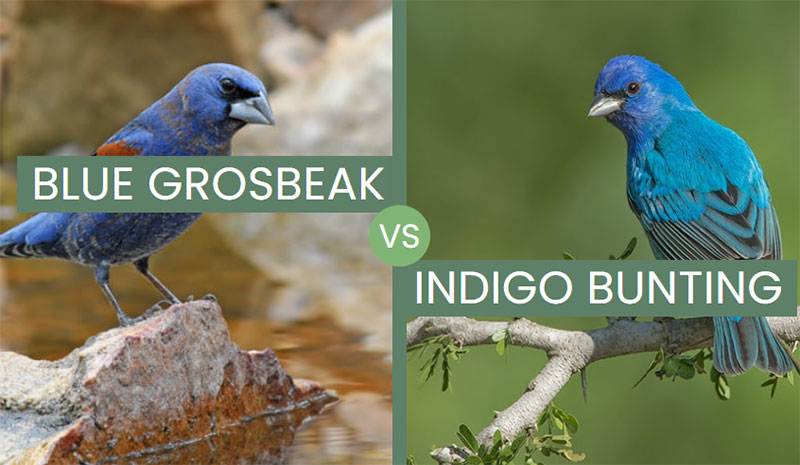Blue Grosbeak vs Indigo Bunting – two of the most beautiful birds in North America. With rich, deep blue plumage, it can seem like these breathtaking birds would be more at home in the Amazon or some other exotic locale!
These small finches are also related to each other and can look very similar. The easiest way to separate them is to look at their wings. If the bird has strong brown wing bars, it’s a Blue Grosbeak. If it lacks wing bars, or has subtle wing bars, it’s probably an Indigo Bunting.
Want to learn more about these gorgeous birds and how to identify them? See this article that compares the Blue Grosbeak and the Indigo Bunting.
On this page
Body & Shape
Both Blue Grosbeaks and Indigo Buntings are small, sparrow-like finches with conical beaks, fairly short, rounded wings, and a medium-length rounded tail.
As with many songbirds, they also have medium-length legs and strong feet for perching on branches.
These birds also both have a hint of a crest, although this is more pronounced in the Blue Grosbeak. Another difference is that the Blue Grosbeak’s bill is larger and heftier than the Indigo Bunting.
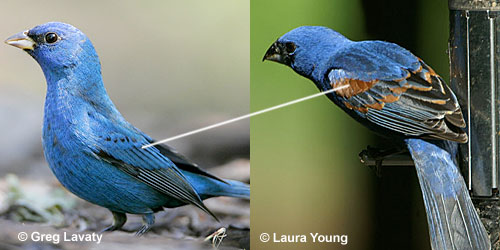
Indigo Bunting (left) and Blue Grosbeak (right) side by side
The males are beautiful blue birds, although the Indigo Bunting is darker, deeper blue, and can look blackish in certain lighting. The main difference between them is in their wings; rufous wing bars for the Blue Grosbeak, and plain wings for the bunting.
Related: Are blue birds really blue?
Identifying female Blue Grosbeaks and Indigo Buntings can be tricker than the males. Both are plain, pale brown finches with hints of blue on their rumps and tails. Each also has a buff eyering. However, the female grosbeak has plain underparts, while the female bunting often shows blurry streaks and usually has a contrasting, pale throat.
The female Blue Grosbeak also has more obvious brown wing bars.
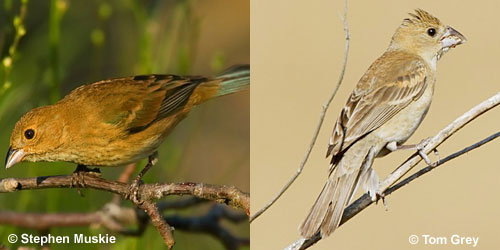
Indigo Bunting (left) and Blue Grosbeak (right) females
Blue Grosbeak vs Indigo Bunting Size
Each of these small birds is similar in size to sparrows, but the Blue Grosbeak is a bit bigger. Blue Grosbeaks are 6.75 inches long, while Indigo Buntings are more than an inch smaller and have an average length of 5.5 inches.
The Blue Grosbeak weighs more and is 0.98 ounces on average compared to 0.51 ounces for the Indigo Bunting.
When Blue Grosbeaks and Indigo Buntings are seen in the wild, these differences in size and weight are notable.
The grosbeak looks like a chunkier bird with a bigger head, while the bunting looks slighter, smaller, and more like the same size as a small sparrow.
In flight, the differences in size and weight between these two birds are also notable. Blue Grosbeaks seem to fly heavier than the smaller, more agile Indigo Bunting.
Speed
Neither of these species are particularly fast fliers. For this reason, they prefer to stay in or near cover. That way, if a hawk or other predator attacks them, they can zip into and hide in a dense bush or low tree.
Blue Grosbeaks and Indigo Buntings have similar flight speeds and are believed to fly as quickly as 20 miles per hour. When escaping a hawk, they may be able to fly faster, but probably not much.
This rather slow flight speed is related to the shape of their short, rounded wings. This shape helps them take flight quickly so they can reach cover, but it doesn’t work as well for fast, long-distance flight.
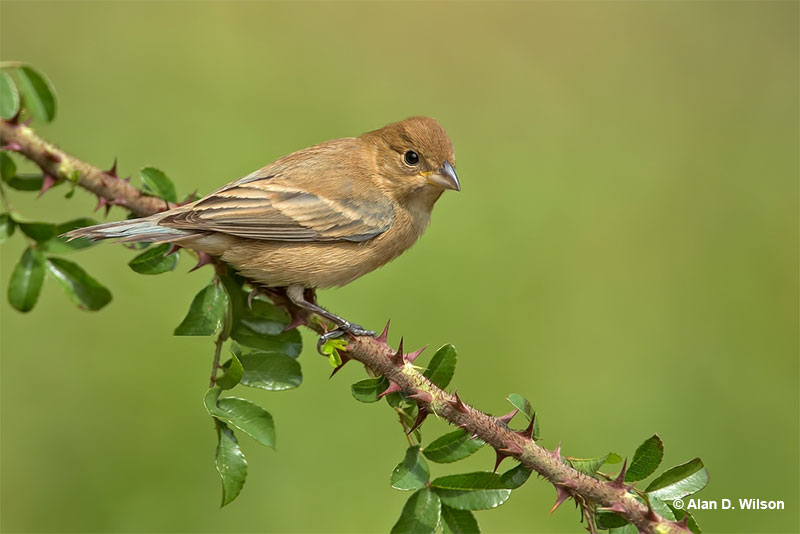
Female Indigo Bunting
Even so, both species are long-distance migrants that fly between North America and Mexico and Central America. To avoid predators, they fly at night and probably use tail winds to fly faster, for longer distances, and for longer periods of time.
Both of these species have a similar, undulating flight pattern. They beat their wings quickly and then hold them closed before quickly beating them again. This makes the bird appear to move up and down or “bounce” as it moves through the air.
Age
The natural lifespans of Blue Grosbeaks and Indigo Buntings are similar to many other small, migratory birds. Although there have been few studies looking at the lifespan of the Blue Grosbeak, the oldest male caught was five years old. In all likelihood, some birds probably live to be nine or ten while many others only live for a few years.
Based on data from the recapture of banded birds, Indigo Buntings appear to have an average lifespan of two or three years. Adults stop breeding at nine years of age, although some birds live longer, including one male that lived to be at least eleven years old.
There are a number of factors that affect the lifespan of these birds. Like other migratory birds, they are affected by habitat destruction on their migration routes and wintering grounds, can perish during bad weather, and die after flying into lit windows at night.
Both species are also preyed on by Sharp-shinned Hawks and Merlins, and nestlings are susceptible to crows and other nest predators. Feeding on or near the ground also makes them susceptible to being caught by feral cats.
The lifespans of these birds are probably also affected by pesticides that reduce available food and make them unhealthy over the long term.
Blue Grosbeak vs Indigo Bunting Behavior
Blue Grosbeaks and Indigo Buntings can live in similar areas. Both frequent brushy areas, often in the same region. They aren’t usually seen at feeders or in urban situations but can show up in urban parks during migration.
During migration, both species (and many other birds) can also occur in backyards planted with native vegetation.
Both also occur on the ground or in low vegetation and are rarely seen perched high in a tree. However, during the breeding season, males of both species often sing from a high perch.
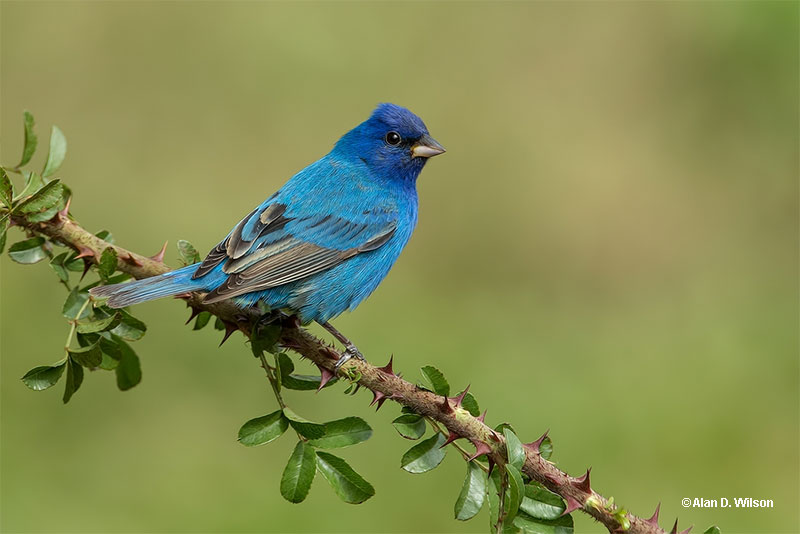
Each of these species forms pairs for the breeding season but form flocks during migration and winter. Sometimes, both can also be seen in the same flock, especially at a good, reliable food source.
In general, though, each species is seen on its own and Blue Grosbeaks form much smaller flocks than Indigo Buntings.
When flocking together, the Blue Grosbeak can chase Indigo Buntings away from food but neither species is particularly aggressive. If they see an owl, or notice a cat, dog, or person near their nest or nestlings, they often perch nearby and make sharp chipping calls.
Blue Grosbeak vs Indigo Bunting Diet
Blue Grosbeaks and Indigo Buntings have similar diets. However, the grosbeak tends to eat larger seeds (such as corn) and eats bigger insects like mantids and big grasshoppers.
There is some overlap in their diets, but the bunting feeds more on grass seeds and small arthropods like small spiders.
Both species also feed on a variety of grass seeds and other low plants, and various types of insects and bugs (although the Blue Grosbeak eats more snails than the bunting).
Each species also forages in a similar fashion. They pick and eat seeds off of low vegetation while perched and also pick bugs and caterpillars from low foliage. Both birds can also forage on the ground although buntings seem to do this more than grosbeaks.
Indigo Buntings might also feed on more buds and berries than the Blue Grosbeak, especially on their wintering grounds.
Location
The Blue Grosbeak breeds in brushy fields and other types of brushy second growth. Where enough bushes are present, it also breeds in grassland habitats and is a summer resident in California, Arizona, and much of the southern USA north to South Dakota and New Jersey.
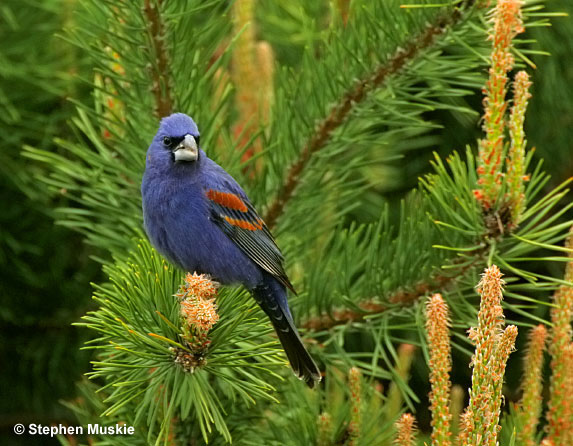
This grosbeak species is also a permanent resident in similar brushy habitats in Mexico south to Central America.
Birds in North America migrate to Mexico, the Caribbean, and Central America for the winter.
The Indigo Bunting is a bird of thick second growth that occurs at the edge of woodlands and places like power line cuts. It spends the summer in such habitats in the American southwest, southern Colorado, and in most of the USA east of the Rocky Mountains.
This beautiful little blue bird also breeds in southern Canada from southeastern Saskatchewan to southeastern Quebec. It winters in brushy and weedy fields in the Caribbean and Mexico south to northern South America.
Nest & Eggs
The Blue Grosbeak uses grass, rootlets and other bits of vegetation to make a somewhat loose cup nest near or close to the ground.
Both sexes help build the nest in a low tree or bush and it has an inside diameter of two and a half inches and a cup depth of two inches.
The female lays four plain white or pale blue eggs and incubates them for around 12 days. The eggs are a bit less than one inch long and probably weigh about 0.1 ounces.
The Indigo Bunting makes a cup nest out of bark strips, twigs, leaves, and other bits of vegetation. The female chooses the nest site, does all of the nest construction, and builds it about three feet off the ground in a low bush or dense, weedy vegetation.
The inside diameter of the nest is two inches and the average depth is a bit more than an inch. The female lays three white eggs that are 0.73 inches long and weigh around 0.07 ounces. She incubates these eggs for around 12 days.
Blue Grosbeak vs Indigo Bunting – Frequently Asked Questions
What’s the difference between a Blue Grosbeak and an Indigo Bunting?
The main difference between a Blue Grosbeak and an Indigo Bunting is the size of the bird and the pattern in the wings. Blue Grosbeaks are more than an inch longer than Indigo Buntings and have reddish-brown wing bars. Female Indigo Buntings also have a paler throat and some streaks on their underparts.
What is the difference between Indigo Bunting and Lazuli Bunting?
The difference between Indigo Buntings and Lazuli Buntings is that the male Indigo is mostly dark blue while the male Lazuli has an orange chest, white belly, and two white wing bars. Female Indigo and Lazuli Buntings are very similar, but female Lazulis have more prominent, pale wing bars, and have buffy, unstreaked underparts.
Is an Indigo Bunting a Grosbeak?
The Indigo Bunting is not a grosbeak but does belong to the same family as the grosbeaks and cardinals.

